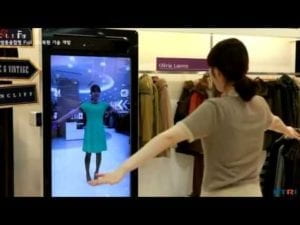Prior to going to the Chronus Exhibition, I have been to museums such as the MET, and museums back home such as MARCO. I love interpreting paintings and sculptures, as well as interpreting their meaning. However, it was not until the Chronus Exhibition that I personally say art and modern technology being fused together in a way so that the art itself responds to humans. The Chronus Exhibition installments were very interesting to me because I saw dynamic art. It seemed like everything was moving in a way, and sometimes you could see how certain things you did made the art move or do something in particular. It was interesting to see how the art installments would react to you, and it was interesting to try to figure out the purpose and the functionality of these installments. Many of them I thought were too complicated for me to understand their purpose or what I was supposed to do to interact with them. A particular example in the exhibition that I not only enjoyed visually but found it engaging and relatively easy to figure out was Zhang Hua’s “Artificial Intuition”. This installment would predict where people would go next and would attempt to block you. It kind of felt like a human vs machine intelligence kind of thing.
I recently came across interactive “mirrors”. They can be used to help costumers find clothes they like the most. The concept is you have something like a mirror (in reality the examples I have seen are more like a camera and an LED screen instead of actual reflective glass) and the mirror will change your clothes on screen. It could change color, length, and even change entire outfits in a matter of seconds. The clothing brand CLO released a mirror (Magic Mirror) in which people can stand in front of the mirror and through their movement select to change outfits. Instantly the mirror adapts to your movements and dresses you up with your selected outfit. One specific trait of this mirror is that you can grab the virtual outfit and it will react you grabbing it. The downside is that sometimes the mirror does not adapt to rapid movements and the virtual outfit is not properly accommodated to you. Another example of an interactive mirror is Memory Mirror, which was installed on a Neyman Marcus store in the US. Like CLO’s mirror, the Memory Mirror was designed to help customers choose whichever outfit they like the most. The difference is that the Memory Mirror just compares side to side recordings of what you have worn before and what you are wearing now. It does, however, change the color of the outfit you are wearing accurately. Because CLO’s mirror can automatically change your outfit without the person having to change it I would say CLO’s besides its downsides is the most successful at helping the customer.
CLO Mirror: https://www.youtube.com/watch?v=rMUsVIB-anY
Memory Mirror (Meyman Marcus): https://www.youtube.com/watch?v=Xp7s_kCHJS0
In my group project, I defined interaction as a conversation, it is a dialogue, a transmission and a tool that requires an input a process and an output. For it to be a more complex interaction, there must be an input a process and an output that can go back and forth. By the nature of it, you would need a relationship. To add to what I had said before I would like to stress in one key element: Understanding. In the communication that interaction facilitates there must be an understanding of how and what to communicate. In my midterm project, one struggle was making sure people knew, without us telling them, what they had to do. The interaction was facilitated when we were able to design the project in order for them to understand or sort off expect what we are going to get back. In the CLO mirror for instance, once you step close enough a “menu” will be shown on screen. Your hand gestures will be traced with a circle, and once your arm goes forward, you will select an item. I think the design facilitates interaction between the machine and the human, especially considering there is an almost immediate response from the machine when the human does something.

